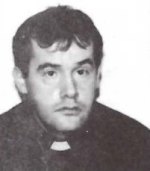Fenor 1996 – Diary of a Parish Community
“The Purgatorial Society”
by Bob Rockett
Are we going to let it die? This is a question that can only be answered by the people of the parish. It’s the oldest institution in the parish and probably the only one of its kind in existence but, sadly, the information confirming its origin and history has not been preserved. Worse still is the fact that not too many reading this will know what it is all about.
We are, of course, talking about the Purgatorial Society. We have good reason to believe it was founded sometime in the 17th century and has an unbroken record to the present time. But it is in jeopardy now for want of an injection of an increase in its membership and some young blood to bring it up to date and into the 21st century.
Those who, perhaps, have never heard of it will ask what is its function. It was started to help people in times of distress and, from what we can gather, it was known in its beginning as ‘The Box’. A box was placed somewhere, probably at the church door, and those who could afford it contributed. Funds from this were distributed to those in dire straits through serious illness or death. It was later updated as a means whereby anyone could, by paying a small subscription twice a year, provide something towards the cost of their funeral. There was also the benefit of perpetual Masses for living and deceased members and many of past generations joined just for the Mass benefit.
In this age of social welfare and so many insurances, it’s hard to realise that, fifty years ago, so many people were so badly off. There were occasions when the breadwinner of a family, having been ill over a long period, had died without a penny in the house. If he was a member of the society, the family had only to go to the treasurer and get instant cash. It was considered a great provision against the worry of such a situation arising.
The society served the parish well and it deserves to be continued, if only for its history. Sadly, the records don’t seem to have been preserved. This may be due to the fact that its secretaries were appointed for life and continued to hold office even when they were no longer capable. Also, there seem to have been problems in getting the books handed over. Most families in the parish had an input in its survival down the years. Here are the names of some of them I can recall: James Denn, John Connolly, David Beresford, John Rockett, John Power, Johnny Molloy, and Paddy Flynn, who are all now sharing in the Masses for deceased members. The present committee is composed of Bobby Power, Jimmy Gough, Jimmy Delaney, Denis Hynes, Jimmy Walsh, Bob Rockett, and Michael Flynn. The secretary is Mrs. Mary Power. The subscription – the benefits are £50 on the death of a fully-paid member with sharing the Masses. Those age 25 are eligible to join for the yearly subscription. Others are taken in at the discretion of the committee by paying the equivalent of what they would have paid had they joined at 25 years of age.
Today there are many services, perhaps, filling the role of the society and it may not be so necessary, but its function could easily be updated to bring it up to present-day requirements. The chairman and committee earnestly ask the people of the parish and all its surroundings to give the matter some consideration. The A.G.M. takes place in February, 1997.
[ Associations concerned with praying for the dead are older than Christianity. Provision for burial was first made by “La Compagnia della Pietà”, founded in Rome in 1448. – Comms Team. ]



